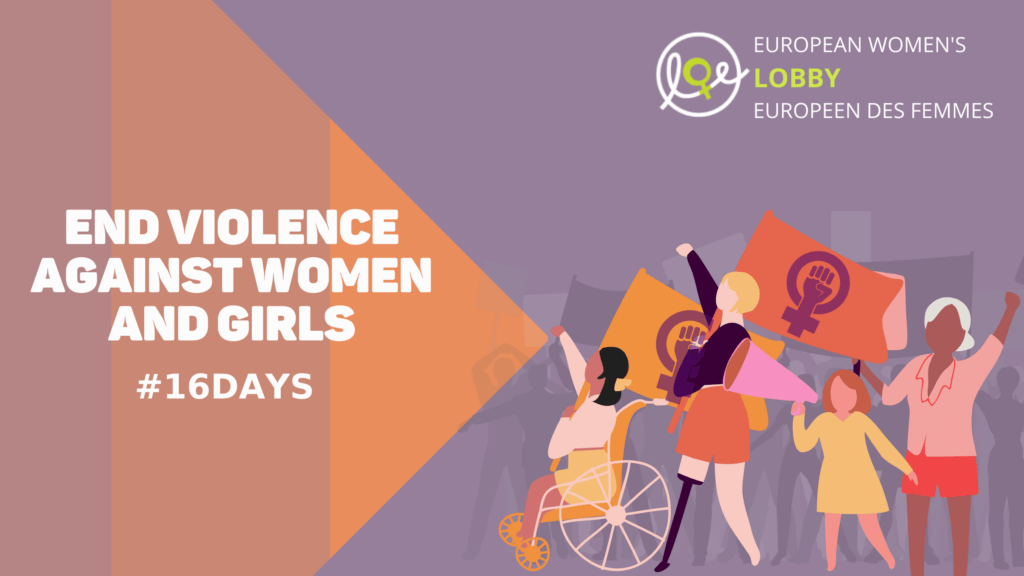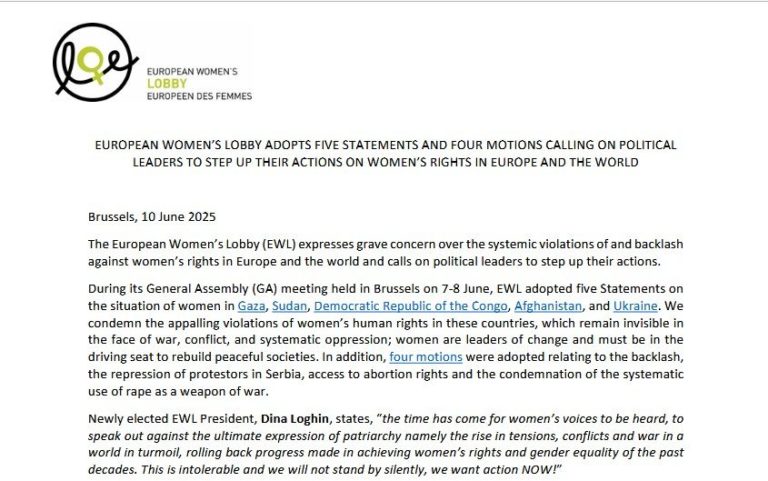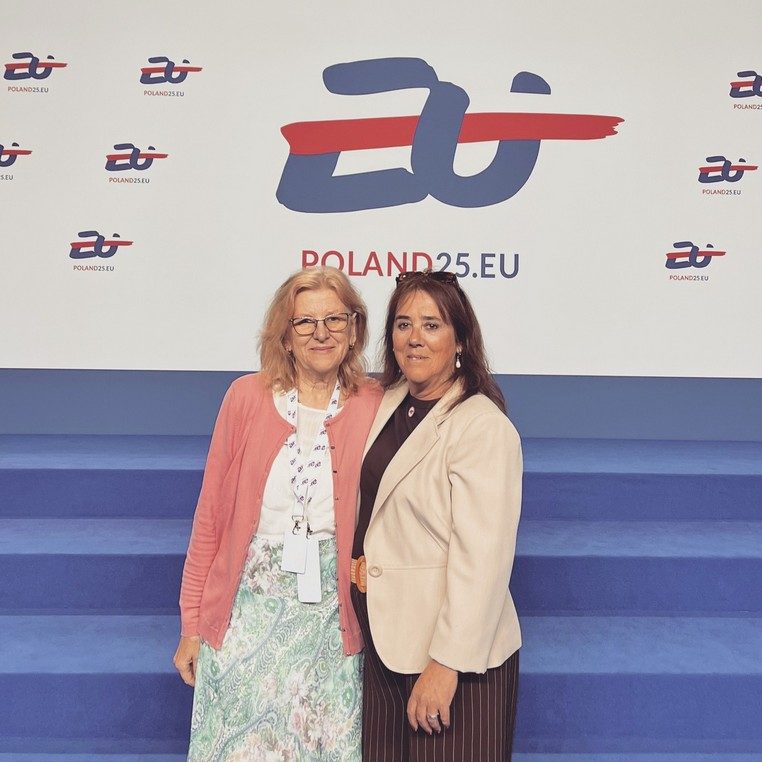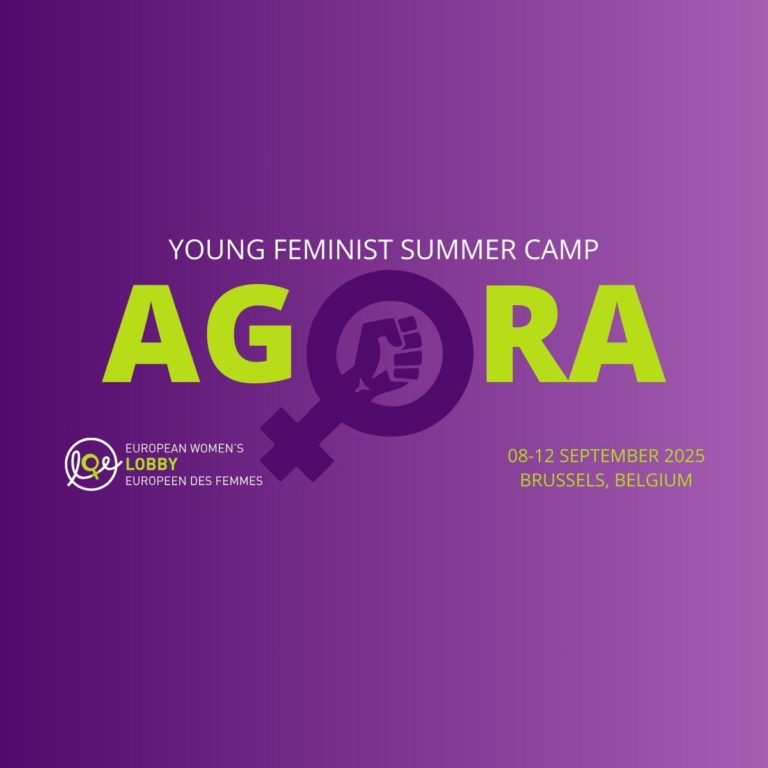[Brussels, 25 November 2022] 25 November marks the International Day for the Elimination of Violence Against Women (VAW) and the start of the 16 Days of Activism to end VAW. On this occasion, the European Women’s Lobby (EWL) is urging the EU and all European countries to make Europe a safe place for all women and girls by adopting EU legislation on preventing and combating all forms of violence against women and girls.
Male violence against women and girls is the most pervasive violation of women’s human rights that has life-long implications for women’s physical and mental health, and whose effects know no borders. There is not a single country in Europe where women and girls are free from male violence. There is also not a single area in any woman or girl’s life where she is not exposed to the threat or the realisation of acts of violence: from the private sphere at home to the public sphere, including the workplace and the online spaces.
In the EU, 1 in 3 women have suffered physical and/or sexual violence and 1 in 2 women have experienced sexual harassment since the age of 15. As warned by Simone de Beauvoir more than half of a century ago, “it only takes a political, economic or religious crisis for women’s rights to be put in jeopardy”. Women’s organisations have been warning about the alarming spikes in the number of cases of violence against women and girls during the times of crises, such as the COVID-19 pandemic, the war in Ukraine, the ongoing economic crisis and the rise of authoritarianism across the globe. The instances of violence range from intimate partner and sexual violence, to sexual exploitation, online violence and hate speech. Overall, violence against women and girls threatens the security of half of the population in the EU and there can be no peace and security while women fear for their safety. That is why every year, women’s organisations and activists from around the world mark the 16 Days of Activism to end violence against women and girls.
On this occasion, the EWL is urging the EU to give the world a robust political message about the EU’s commitment to fight this pervasive form of women’s rights violation and discrimination. We call to develop a strong and comprehensive EU legal framework to combat all forms of violence against women and girls and disrupt the full continuum of violence; so that women in the EU can have the same level of protection no matter where they live.
Concretely, the EWL is calling on the European Parliament and the EU Council to step up their efforts to enhance and swiftly adopt the Directive on combating violence against women and domestic violence. The proposal issued by the European Commission in March 2022 is a major step and a key opportunity to fill significant legislative gaps on VAWG across the EU when it comes to sexual exploitation of women and computer crimes, two of the Eurocrimes listed in the EU treaties. The Directive brings significant improvements to the legal definitions of key forms of violence.
When this Directive is adopted and adequately implemented, women who have been victims of rape, female genital mutilation, non-consensual sharing of intimate or manipulated images, cyber harassment or cyberstalking will have better access to justice and to protection mechanisms no matter where they live in the EU. It is important to note that there is still no legislation covering the aforementioned forms of online violence in many EU Member States and that victim blaming attitudes are still highly persistent, especially for victims of sexual violence and rape that are required to prove the use of physical force. Furthermore, the proposed Directive aims at integrating the standards of the Council of Europe Convention on preventing and combating violence against women and domestic violence, the Istanbul Convention, in order to improve prevention policies, protection and access to justice for victims across the EU.
The EWL now counts on the European Parliament and the EU Council to enhance the current proposal for a Directive. For this reason, EWL is happy to release its updated analysis of the Directive and its list of amendments to the proposal of the European Commission.
The EWL calls concretely to ensure that there are no gaps left when it comes to legislation against sexual exploitation of women. All aspects of sexual exploitation of women should be covered, including sexual violence, sexual harassment, the commercialization of women’s bodies in prostitution, surrogacy and pornography; and other forms of abuse over women’s sexuality and reproductive health, such as forced abortion, forced sterilization and forced marriage. Furthermore, the EWL has a concrete set of recommendations to ensure a strong gender-sensitive perspective.
“EWL is aware that this Directive is a very important piece in the EU legislative puzzle on violence against women. However, the puzzle will not be complete until there is a consistent approach to address the full continuum of violence against women and girls including our demands for a strong legislation against sexual exploitation of women and girls” noted Réka Sáfrány, President of the European Women’s Lobby.
With a view of precisely developing this comprehensive EU legislative framework to prevent and combat all forms of violence against women and girl, the EWL calls on:
- The European Commission to reinforce the EU legal basis and launch the procedure for the recognition of violence against women and girls as a Eurocrime (activating the “passerelle clause”), as requested by the European Parliament on many different occasions and as committed in the European Commission Gender Equality Strategy 2022-2025.
- The upcoming Swedish Presidency to take swift action to ensure that the EU accedes to the Convention at a qualified majority. It is obnoxious to see that the EU accession to the Istanbul Convention remains blocked in the Council of the EU since 2018 without any justification but the lack of political courage to ensure safety of women and girls. The Istanbul Convention remains the most comprehensive legislative instrument in Europe to date and it is both urgent that the EU accedes and all the Member States ratify and implement it adequately, closely following the GREVIO recommendations, especially when it comes to adopting a gender-sensitive perspective.
- The EU to appoint an EU Coordinator for ending all forms of violence against women and girls, with a strong political mandate to ensure coherence in the implementation of all the different legislative instruments in place and future legislative and policy developments with the goal of ending the full continuum of violence against women and girls.
During the 16 Days of Activism, the EWL will run a social media campaign and develop key advocacy activities to raise awareness and disseminate our calls for EU action to end all forms of male violence against women and girls. EWL will also give further visibility of our members’ campaigns and actions across Europe at national and EU level. We invite you to join the action, amplify our messages and help us create a Europe that is safe for all!
ENDS
— –
The European Women’s Lobby is the largest umbrella organization of women’s associations in Europe. Founded in 1990, the EWL works to promote women’s rights and equality between women and men and represents more than 2000 organizations across Europe.
Contact:
Mirta Baselovic, Communications and Media Coordinator
baselovic@womenlobby.org
Laura Kaun, Policy and Campaigns Director
kaun@womenlobby.org



